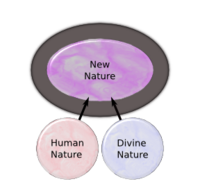Difference between revisions of "Monophysitism"
m (link) |
(Added a diagram to represent Eutyches view of Christ's nature.) |
||
| Line 1: | Line 1: | ||
| + | [[Image:Monophysite.png|right|200px|thumb|Eutyches asserted that human nature and divine nature were combined into the single nature of Christ]] | ||
| + | |||
'''Monophysitism''' is a [[Christology|Christological]] [[heresy]] that originated in the 5th century A.D. Its chief proponent was the [[monk]] [[Eutyches]], who stated that in the person of [[Jesus Christ]] the human nature was absorbed into the divine nature like a cube of sugar dissolves in a cup of water. Therefore, Christ was left with only one nature, the Divine (Greek ''mono-'' one, ''physis'' - nature). This is to be contrasted with the [[miaphysitism]] which is professed by the [[Oriental Orthodox]] churches. | '''Monophysitism''' is a [[Christology|Christological]] [[heresy]] that originated in the 5th century A.D. Its chief proponent was the [[monk]] [[Eutyches]], who stated that in the person of [[Jesus Christ]] the human nature was absorbed into the divine nature like a cube of sugar dissolves in a cup of water. Therefore, Christ was left with only one nature, the Divine (Greek ''mono-'' one, ''physis'' - nature). This is to be contrasted with the [[miaphysitism]] which is professed by the [[Oriental Orthodox]] churches. | ||
Latest revision as of 11:21, December 18, 2009
Monophysitism is a Christological heresy that originated in the 5th century A.D. Its chief proponent was the monk Eutyches, who stated that in the person of Jesus Christ the human nature was absorbed into the divine nature like a cube of sugar dissolves in a cup of water. Therefore, Christ was left with only one nature, the Divine (Greek mono- one, physis - nature). This is to be contrasted with the miaphysitism which is professed by the Oriental Orthodox churches.
Eutyches' position on monophysitism is often referred to as Eutychianism, a position that went beyond the Christology as expressed by Cyril of Alexandria and is also anathematized by non-Chalcedonians who accept the faith of Cyril. Eutyches formulated this doctrine in response to the heresy of Nestorianism, which divided the person of Christ almost to the point of having two separate persons (not two natures, as the Orthodox believe).
Another branch of monophysitism, called Apollinarianism, holds that Christ had a human body and human "living principle," but that the Divine Logos had taken the place of the nous, or "thinking principle," analogous but not identical to what might be called a mind in the present day.
Monophysitism (particularly Eutyches' variety) was condemned at the Fourth Ecumenical Council, held in Chalcedon in the year 451. Apollinarianism had previously been condemned at the Second Ecumenical Council in 381.
External links
- Wikipedia's article on Monophysitism
- Eastern/Oriental orthodox statements
